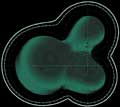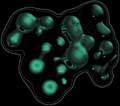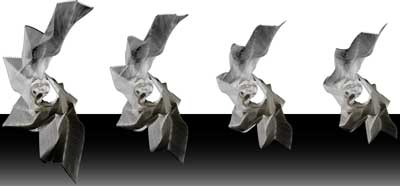|
In
this echo of tragedy, the subject is mediated by the Universal Turing
Machine, which will, in due time, prove to be a gnostic medium that operates
on the logic of functional synthesis. It is a machinic alchemy of subjectivation
that enfolds both the subject and the object of architecture into this
instrumental medium by generating a universal surface upon which a mutant
reality can exfoliate into a possible world. This tragic dimension is
the scene of a transfusion where the Subject of speculative Idealism finds
him/herself immersed into the manifold cockpit of the topological surface
now being engendered by the Universal Turing Machine. It is a trajectory,
or a tragic transport, that becomes infused with the medium by steering
from within the infinite movements of thought and lines of flight in order
to overcome, through a dialectics of transgression, the fabric of mimetology
brought on by the machine of the double bind. It is simultaneously a catharsis
of the subject and of the medium that represents both the substance of
Aristotelian mimesis as a mode of poesis and mimesis in the sense of mimetism
or imitation. It is this aspiration for overcoming through sublimation
that turns into a play of mourning, which lies behind every metaphysical
desire, that induces a philosophy of the tragic effect, or tragic pleasure
of the sublime, by situating the subject of architecture in an in-between
space of melancholy, or, to use Plato's designation, metaxy. Even
though it is at once the nearest and yet the farthest from absolute fulfillment,
it may require the intrusion of the caesura so that what appears is not
the alternation of representations or simulations but the limits of representation
itself.
With
the publication of the paper On Computable Numbers, with an Application
to the Entscheidungsproblem in 1936, Alan Turing launched the specification
for an abstract machine that would ultimately engender a new world by
laying out a new plane of immanence specific to its mode of formal implementation.
This plane is the virtual arena upon which diagrammatic flows and constructions
are instantiated by the abstract machine. The birth of the Universal Turing
Machine (UTM) marks the inauguration of the Hyperzoic Era (the artificial
life of self-organizing systems) by redefining the projective content
of the plane of immanence as information-theoretic in origin. It is the
harbinger of a new breed of biomechanical species and carries with it
the germ of a Brave New World more fantastic and hyperbolic than anything
we have seen in the history of human civilization. In its most significant
form, the UTM is not merely another instrument in the history of technical
inventions ; it is a computational monad that redefines a new plane of
immanence as the spectacle of a second order nature transposed onto the
cultural universe of humanity that is founded upon the first order nature.
As a generative mechanism, the UTM has brought to the foreground a universe
of counterfactual possibilities by showing that these potential states
of affairs are inextricably woven into the invisible fabric of reality
itself. Its latent ambition is to exfoliate this reality in all its manifestations
through the inner workings of the Turing Dimension : a linear sequence
of cells that function as the channel through which information is processed
to form the digital economy of the Universal Turing Machine.
The
UTM is a logical counterpart of Leibniz's idea of the metaphysical
monad. It is a computational monad that is founded upon the classical
model of computation due its reliance on the mechanism of classical logic
for its operation. As such, the UTM is an abstract machine composed of
a linear tape, that is potentially infinite in length and is divided into
squares or cells, and a device called a head which reads and re-writes
binary digits registered on each cell according to the instruction set
of the program. The tape serves as a receptacle for storing as well as
for processing binary information.(…)
The
notion of universality derives from the fact that every UTM can compute,
according to the Church/Turing Thesis, anything that is logically computable
and can therefore model and nest within itself any model of computation,
classical or otherwise. As such, it is a simple conceptual mechanism capable
of perpetually inducing an internal model, or perception (Leibniz's
term for the same feature within a monad), of the world by means of an
internal principle that continually modifies its internal state to arrive
at a more comprehensive version of the model or perception of the world.
In other words, the UTM is a logical subset that can compute the potential
content of the larger set that is the universe itself. Consequently, by
the nature of its embeddedness, it is capable of altering the content
of the universe by further computing the numerical substance of the cosmos
and staging it onto the plane of immanence as diverse modalities of possible
existence. According to Rolf Landauer of IBM, who has done fundamental
research into the material and energetic aspect of computation, not only
does physics determine what computers can do, but what computers can do,
in turn, will define the ultimate nature of physical laws. This is a profound
and radical idea that necessitate a new paradigm concerning the nature
of computation and, consequently, of our role as active participants,
or agents, in the evolution and transformation of the universe at large.
The
Universal Turing Machine therefore is a machinic idea of a perpetual computing
system, or an abstract evolutionary machine, that processes information
through sequential iteration of bits by registering them on the linear
tape of the machine that is potentially infinite in length. As such, it
is endowed with the latent capacity to self-organize and transforms its
internal states, at least in principle, into all possible states of a
monad without end. Even though its initial design is predicated by the
need to delineate the consistency of the sequence of steps necessary in
the formation of a mathematical proof, a response made by Alan Turing
to David Hilbert's call (1900) for resolution to the so-called decision
problem, the UTM has transcended its original function by overcoming its
task as an instrument of representation. It has now entered into the domain
of self-organizing systems with the ambition to assert its autonomy as
a mode of existentiation, or auto-projection. This is an ontological status
distinct from a condition that is dependent, as a prime mover, solely
on external forces that instantiate its will to action. In other words,
the UTM is a primitive precursor of a biomechanical species with the metaphysical
ambition to embody a machinic form of artificial life and neural intelligence.
Since the UTM is the simplest and the most general type of computing system,
its internal principle or program can be made to accommodate a generalized
form of genetic algorithm that could evolve through self-modification
and optimization of its internal states. It could, in principle, evolve
through self-replication and mutation into ever more complex states of
monadic encoding by incorporating new axioms into its existing matrix
of axioms. In the process, it would bifurcate into other self-replicating
UTMs, each of which in turn would bifurcate and nest other self-replicating
UTMs to form an epigenetic landscape of computational monads or a machinic
phylum of Universal Turing Machines. Even though the Leibnizian monad
continually engages in simultaneous, albeit non-linear, modification of
multiplicities as it develops into higher levels of complexity, the UTM
is a one-dimensional cellular automata that self-organizes and transforms
itself by incessantly rewriting the binary digits registered on the tape
that constitutes the Turing Dimension. It is a one-dimensional universe
of monadic states generated by the perpetually evolving code of the machine.
|


|










